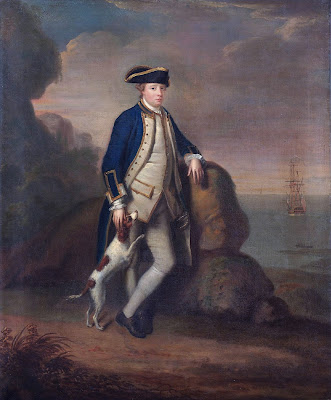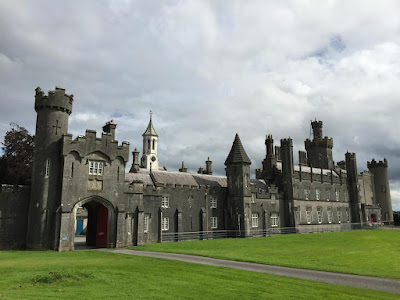The pedigree registered at the College of Arms shows that this family was holding the Manor of Netherhall in Pakenham, Suffolk, by the end of the 11th century, as vassals of the Abbey of Bury St Edmunds. About the year 1100 the church at Pakenham was founded by WALTER, who had with various other children an eldest son named PETER.
The latter left no legal issue, but on his death his illegitimate son, ANSELM, seized the manor to the exclusion of his father's sisters, and succeeded un passing it on to his eldest son, MASTER ROBERT DE PAKYNHAM - the first bearer of this surname. Master Robert, who granted lands in Kirtling, Cambridgeshire, to hissons in 1252, was father of MASTER JOHN DE PAKENHAM, known as "le Clerk."
JOHN LE CLERK married Muriel ________, and by her had issue,
John (Sir);WILLIAM (Sir), Justice of the King in Eyre.
The second son,
SIR WILLIAM DE PAKENHAM, the Judge, added largely to his estates in Norfolk and Suffolk.
The eighth in descent from him was
HUGH PAKENHAM, High Sheriff of Wiltshire, 1459, who died in the reign of HENRY VII, leaving issue,
EDMUND PAKENHAM, born ca 1547, wedded Frances, daughter of Francis Seckford of Seckford Hall, Suffolk.
The eighth in descent from him was
HUGH PAKENHAM, High Sheriff of Wiltshire, 1459, who died in the reign of HENRY VII, leaving issue,
John (Sir), his successor;The first member of the family who settled in Ireland,
Nicholas, grandfather of SIR EDWARD PAKENHAM;
Anne, mother of Sir Henry Sidney KG, Lord Deputy of Ireland.
EDMUND PAKENHAM, born ca 1547, wedded Frances, daughter of Francis Seckford of Seckford Hall, Suffolk.
For many years he was secretary to his first cousin, Sir Henry Sidney, Lord Deputy of Ireland, but in 1595 was appointed Clerk Comptolller of the Revels to ELIZABETH I.
He died in 1605, having had with other issue,
Sir Philip;Edmund;ROBERT.
The third son,
ROBERT PAKENHAM, born in 1592, was father of
HENRY PAKENHAM (1618-91), seated at Pakenham Hall, County Westmeath, in the reign of CHARLES I, having obtained a grant of the lands of Tullynally, in that county, which he so designated.
Mr Pakenham represented the borough of Navan in the Irish parliament after the Restoration.
He married firstly, Mary, daughter of Robert Lill, of Trim, County Meath, by whom he had four sons and three daughters; and secondly, Anne, daughter of Sir Robert Pigot, by whom he had one son.
Mr Pakenham was succeeded by his eldest son,
SIR THOMAS PAKENHAM (1649-1703), Knight, MP for Augher, 1695-9, a lawyer of eminence, and prime sergeant-at-law in Ireland, who wedded firstly, in 1673, Mary, daughter of Richard Nelmes, and had issue,
Sir Thomas was succeeded by his eldest son,
EDWARD PAKENHAM (c1680-1721), MP for County Westmeath, 1713-21, who was succeeded by his eldest son,
THOMAS PAKENHAM (1713-66), High Sheriff of County Westmeath, 1741, who married, in 1739, Elizabeth, daughter and sole heir of Michael Cuffe (and niece of Ambrose Aungier, 2nd and last Earl of Longford (1st creation) of that family, to whom her father was heir), and had issue,
His lordship was succeeded in the barony of Longford by his elder son,
EDWARD MICHAEL (1743-92), 2nd Baron, Captain RN, MP for County Longford, 1765-6, who married, in 1768, Catharine, second daughter of the Rt Hon Hercules Langford Rowley, and Elizabeth, Viscountess Langford, and had issue,
His lordship was succeeded by his eldest son,
THOMAS, 3rd Baron (1774-1835), who inherited the EARLDOM OF LONGFORD at the decease of his grandmother, Elizabeth, Countess of Longford, in 1794.
His lordship espoused, in 1817, the Lady Georgiana Emma Charlotte Lygon, daughter of William, 1st Earl Beauchamp, and had issue,
EDWARD MICHAEL (1817-60), 3rd Earl,
TULLYNALLY CASTLE, otherwise Pakenham Hall, near Castlepollard, County Westmeath, has been the home of the Pakenhams for over 350 years.
Mr Pakenham represented the borough of Navan in the Irish parliament after the Restoration.
He married firstly, Mary, daughter of Robert Lill, of Trim, County Meath, by whom he had four sons and three daughters; and secondly, Anne, daughter of Sir Robert Pigot, by whom he had one son.
Mr Pakenham was succeeded by his eldest son,
SIR THOMAS PAKENHAM (1649-1703), Knight, MP for Augher, 1695-9, a lawyer of eminence, and prime sergeant-at-law in Ireland, who wedded firstly, in 1673, Mary, daughter of Richard Nelmes, and had issue,
EDWARD, his heir;He espoused secondly, in 1696, Mary, daughter of Sir Daniel Bellingham Bt.
Thomas;
Frances.
Sir Thomas was succeeded by his eldest son,
EDWARD PAKENHAM (c1680-1721), MP for County Westmeath, 1713-21, who was succeeded by his eldest son,
THOMAS PAKENHAM (1713-66), High Sheriff of County Westmeath, 1741, who married, in 1739, Elizabeth, daughter and sole heir of Michael Cuffe (and niece of Ambrose Aungier, 2nd and last Earl of Longford (1st creation) of that family, to whom her father was heir), and had issue,
EDWARD MICHAEL, his successor;Mr Pakenham was elevated to the peerage, in 1756, in the dignity of Baron Longford; and his lady, in 1785, COUNTESS OF LONGFORD.
Thomas, an admiral of the red;
Elizabeth; Frances; Helena.
His lordship was succeeded in the barony of Longford by his elder son,
EDWARD MICHAEL (1743-92), 2nd Baron, Captain RN, MP for County Longford, 1765-6, who married, in 1768, Catharine, second daughter of the Rt Hon Hercules Langford Rowley, and Elizabeth, Viscountess Langford, and had issue,
THOMAS, his heir;
Edward Michael (Sir), GCB, major-general;
Hercules Robert (Sir), CB;
William, Captain RN;
Henry (Ven), Archdeacon of Emly;
Elizabeth; Helen; Catherine; Helen; Caroline Penelope.
 |
| Edward, 2nd Baron Longford |
His lordship was succeeded by his eldest son,
THOMAS, 3rd Baron (1774-1835), who inherited the EARLDOM OF LONGFORD at the decease of his grandmother, Elizabeth, Countess of Longford, in 1794.
His lordship espoused, in 1817, the Lady Georgiana Emma Charlotte Lygon, daughter of William, 1st Earl Beauchamp, and had issue,
EDWARD MICHAEL, his successor;He was succeeded by his eldest son,
William Lygon;
Thomas Alexander;
Charles Reginald;
Henry Robert;
Frederick Beauchamp;
Francis John;
Catherine Felicia; Georgiana Sophia; Louisa Elizabeth.
EDWARD MICHAEL (1817-60), 3rd Earl,
- Edward Michael Pakenham, 3rd Earl (1817–60);
- William Lygon Pakenham, 4th Earl (1819–87);
- William Pakenham, Lord Silchester (1864–76);
- Thomas Pakenham, 5th Earl (1864–1915);
- Edward Arthur Henry Pakenham, 6th Earl (1902–61);
- Francis Aungier "Frank" Pakenham, 7th Earl (1905–2001);
- Thomas Francis Dermot Pakenham, 8th Earl (b 1933).
The heir apparent is the present holder's eldest son Edward Melchior Pakenham, styled Lord Silchester.
TULLYNALLY CASTLE, otherwise Pakenham Hall, near Castlepollard, County Westmeath, has been the home of the Pakenhams for over 350 years.
The original 17th century fortified house was remodelled first as a comfortable Georgian mansion, then as a huge rambling gothic revival castle in the early 1800s, by the 2nd Earl.
Mark Bence-Jones describes it as having
The interiors, part Georgian, part Gothic revival, have a fine collection of furniture and pictures.
Guided tours also take in the splendid Victorian kitchens and laundries, complete with all their equipment.
THE GARDENS, like the castle are on a magnificent scale, taking in nearly 12 acres.
Terraced lawns around the castle overlook superb 18th century parkland.
The adjoining woodland gardens and walled gardens date largely from the early 19th century and encompass a grotto of eroded limestone from nearby Lough Derravaragh and two ornamental lakes.
The present owners have added a Chinese garden, complete with pagoda and a Tibetan garden of waterfalls and streams; and a local sculptor has made fantastic woodcarvings in existing roots and trees.
The walled gardens have extensive flower borders and an avenue of magnificent 200 year old Irish yews.
For children, there is also an Adventure Trail leading to the lower lake, and for those who wish to take the gardens more slowly, there is an assortment of delightful, ornamental summer houses and seats, each offering a different view.
First published in November, 2011. Longford arms courtesy of European Heraldry.
Mark Bence-Jones describes it as having
A long, picturesque sky-line of towers, turrets, battlements and gateways stretching among the trees of its rolling park. Tullynally covers a greater area than than any other castellated country house in Ireland; it looks not so much like a castle as a small fortified town; a Camelot of the Gothic Revival.It inhabited in as the family home, now probably one of the largest in Ireland to survive in private hands.
The interiors, part Georgian, part Gothic revival, have a fine collection of furniture and pictures.
Guided tours also take in the splendid Victorian kitchens and laundries, complete with all their equipment.
THE GARDENS, like the castle are on a magnificent scale, taking in nearly 12 acres.
Terraced lawns around the castle overlook superb 18th century parkland.
The adjoining woodland gardens and walled gardens date largely from the early 19th century and encompass a grotto of eroded limestone from nearby Lough Derravaragh and two ornamental lakes.
The present owners have added a Chinese garden, complete with pagoda and a Tibetan garden of waterfalls and streams; and a local sculptor has made fantastic woodcarvings in existing roots and trees.
The walled gardens have extensive flower borders and an avenue of magnificent 200 year old Irish yews.
For children, there is also an Adventure Trail leading to the lower lake, and for those who wish to take the gardens more slowly, there is an assortment of delightful, ornamental summer houses and seats, each offering a different view.
First published in November, 2011. Longford arms courtesy of European Heraldry.




No comments :
Post a Comment